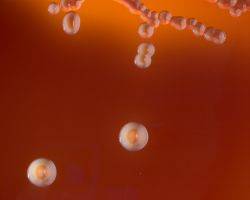SEARCH
Search
Fluorescence_Fusobacterium necrophorum, F. nucleatum and F. species
-
General
long wave (365 nm) UV-light / medium dependent
Fusobact spec yellow-green
Porphyromonas spec orange to brick red
Prevotella spec orange to brick red (only young cultures)
Veillonella parvula red
Clostridium difficile pale yellow to bright yellow
SEE WEBSITE: Fusobacterium necrophorum and Prevotella corporis
UV light, short for Ultraviolet Light, is a type of light energy making up one part of the electromagnetic spectrum, which spectrum includes gamma and x-rays, UV light, visible light, infrared rays, microwaves, and radio waves, listed in order of decreasing frequency and increasing wavelength.
UV light thus has a wavelength shorter than that of visible light, and can not be detected by the human eye. While UV light itself is invisible, it causes many substances to glow or fluoresce in a variety of colors visible to the human eye.
This ability to make the invisible visible makes UV lamps valuable for mineral prospecting, criminal investigations, postal stamp evaluation, and bacteria
Longwave, has a wavelength of from 320 to 400 nanometers. A nanometer is a unit of length used to define wavelengths of energies in the electromagnetic spectrum, equaling one millionth of a millimeter.
-
History
-
Related
-
References
https://www.mineralab.com/AboutUVLight/
http://www.hemltd.ru/export/sites/HemLtd/publications/sections/Normativ/
foreign/Infections/medicine/NHS046/article.pdf
Photo
ErasmusMC, ErasmusMC
Rotterla
C. difficile bacteria fluoresces under UV light. / Credit: Centers for Disease Control and Prevention















